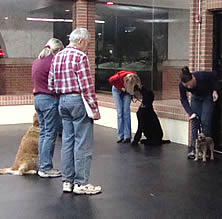It looks like the world is starting to open up again. With more events and activities available, it may be time to think about taking your dog to an in-person dog training class. If you do – look out for your dog!
If you’re here, you’re on board with training your dog at home, often, with short, fast, fun, and effective dog training games. It’s a great way to build a strong, consistent, clear relationship. In-person classes are a great adjunct to your at-home sessions – as long as you look out for your dog. We’ve talked before about training classes, and the importance of making sure your dog gets everything out of them.
Respect, but don’t concede

Ideally, before you sign up for any dog trainer’s in-person class, you would have the opportunity to observe class and talk to some current and former students. These days, that’s probably not possible.
Instead, you have to thread the needle between enthusiastic participation and critical judgement. The easiest way to say this: Don’t do anything to your dog that makes you uncomfortable. No matter who tells you.
And don’t hand over your leash to anyone unless you’re comfortable they would treat your dog as you would.
Know better, do better
For many years the accepted and universal method for dog training involved physical punishment. Collar “pops” were the order of the day. We cringe when we remember how we were taught. And we’re embarrassed and ashamed by the pain we inflicted on our wonderful dogs.
What do you do if the instructor asks, or tells, you to use negative reinforcement on your dog? It could be a choke collar, prong collar, electronic collar, yelling, hitting, any physical or intimidating method.
Avoid confrontation
The simplest thing to do, and we must admit we’ve used this ourselves, is simply to say “Okay” and then ignore the advice. The instructor may think you’re not very bright, but that’s better than damaging your relationship with your dog.
If the instructor thinks you’re just not “getting it,” he or she may reach for your leash to take your dog and show you how it’s done. Don’t let them. Just say you’re not comfortable with that.
Should the instructor persist, it’s time to let them know why you’re not following their instructions. You are a positive reinforcement trainer and prefer to stick to non-punitive methods.
Look out for your dog
You are your dog’s advocate. Stick to your guns and be strong. Both the science and results speak for themselves – positive reinforcement works. You may have to find another class – or stick to home training if there are no other choices.
Your dog would thank you for it, if she knew how you advocate for her.
